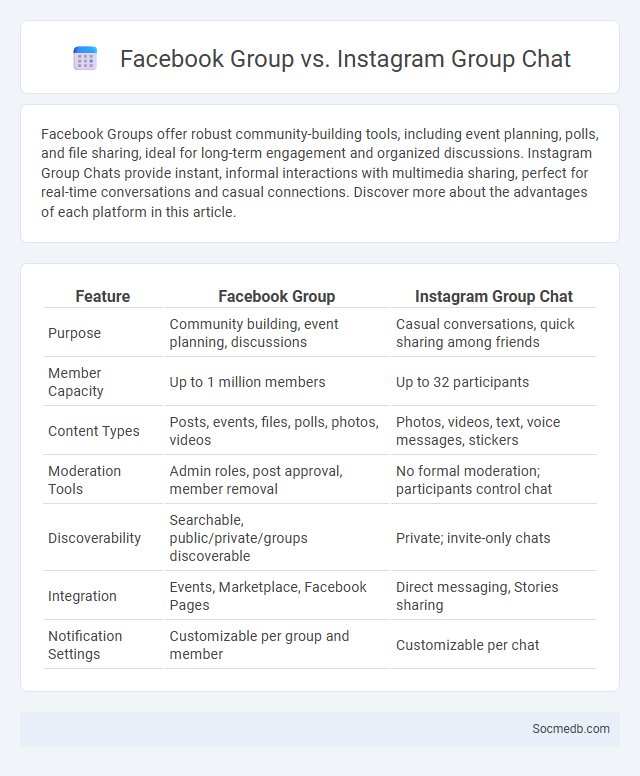
Photo illustration: Facebook Group vs Instagram Group Chat
Facebook Groups offer robust community-building tools, including event planning, polls, and file sharing, ideal for long-term engagement and organized discussions. Instagram Group Chats provide instant, informal interactions with multimedia sharing, perfect for real-time conversations and casual connections. Discover more about the advantages of each platform in this article.
Table of Comparison
| Feature | Facebook Group | Instagram Group Chat |
|---|---|---|
| Purpose | Community building, event planning, discussions | Casual conversations, quick sharing among friends |
| Member Capacity | Up to 1 million members | Up to 32 participants |
| Content Types | Posts, events, files, polls, photos, videos | Photos, videos, text, voice messages, stickers |
| Moderation Tools | Admin roles, post approval, member removal | No formal moderation; participants control chat |
| Discoverability | Searchable, public/private/groups discoverable | Private; invite-only chats |
| Integration | Events, Marketplace, Facebook Pages | Direct messaging, Stories sharing |
| Notification Settings | Customizable per group and member | Customizable per chat |
Introduction to Facebook Groups, Instagram Group Chats, and Groups
Facebook Groups foster community engagement by allowing users to create and join focused interest-based forums for discussion and collaboration. Instagram Group Chats enable private, real-time communication among multiple users, enhancing social interaction within smaller, connected circles. Both platforms leverage group features to facilitate personalized content sharing, community building, and deeper user connections.
Key Features of Facebook Groups
Facebook Groups offer private or public spaces for users to connect around shared interests, facilitating community building and collaboration. Key features include customizable privacy settings, event organization tools, and versatile post formats such as polls, announcements, and multimedia sharing. The platform's integration with Pages and Messenger enhances communication, while insights and moderation controls support active group management and member engagement.
Key Features of Instagram Group Chats
Instagram group chats offer seamless real-time messaging with features such as photo and video sharing, disappearing messages, and custom emoji reactions. Users can create group video calls for up to 8 participants, enabling dynamic discussions and collaboration within the app. The integration with Instagram's Stories and direct message threads enhances user interaction and content sharing among group members.
Overview of Meta’s Group Ecosystem
Meta's Group Ecosystem encompasses a wide range of interconnected platforms including Facebook Groups, Workplace, and WhatsApp Communities, designed to foster communication and collaboration among users. It supports diverse social interactions, from casual gatherings to professional networks, leveraging advanced algorithms for personalized content delivery and engagement. This ecosystem integrates robust privacy controls, extensive moderation tools, and real-time messaging features to enhance user experience and safety across its vast global user base.
Privacy and Security: Comparing Group Platforms
Social media platforms vary significantly in privacy and security features, with GroupMe offering basic encryption while WhatsApp provides end-to-end encryption for group chats, ensuring messages remain confidential. Facebook Groups allow detailed privacy settings but have faced criticism for data breaches and surveillance concerns, impacting trust among users. Telegram combines encrypted group messaging with self-destructing messages and extensive control over membership, positioning itself as a secure option for privacy-conscious users.
Community Building: Engagement Differences
Social media platforms vary in how they facilitate community building and engagement, with Facebook fostering group interactions through shared interests while Twitter emphasizes real-time conversations and trending topics. Your choice of platform influences the type of engagement you receive, whether through comments, shares, or hashtags that amplify your message. Understanding these differences helps tailor your content strategy to maximize interaction and loyalty within your target audience.
Content Sharing Capabilities
Social media platforms offer robust content sharing capabilities that enable users to distribute text, images, videos, and live streams instantly across global networks. Features such as tagging, hashtags, and direct messaging enhance visibility and engagement, facilitating viral dissemination and user interaction. Advanced sharing tools integrate with e-commerce and analytics, optimizing content reach and performance tracking for businesses and influencers.
Moderation Tools and Admin Controls
Social media platforms implement advanced moderation tools and admin controls to effectively manage user-generated content and maintain community standards. Features such as automated content detection, user reporting systems, and customizable admin roles empower moderators to swiftly address violations and prevent harmful interactions. These tools enhance platform safety, support compliance with legal requirements, and foster positive user engagement.
Use Cases: Which Group Platform Suits You Best?
Facebook excels for community building and event organization, making it ideal for businesses targeting diverse age groups and local audiences. Instagram thrives with visual storytelling and influencer marketing, perfect for brands in fashion, beauty, and lifestyle sectors seeking engagement through images and short videos. LinkedIn suits B2B companies and professionals aiming for networking, industry insights, and talent recruitment.
Future Trends in Social Media Groups
Future trends in social media groups emphasize increased use of AI-driven personalization to enhance user engagement and content relevance. Integration of augmented reality (AR) and virtual reality (VR) features is expected to create immersive group experiences. Privacy-focused group management tools will become essential as users demand greater control over their shared information.
 socmedb.com
socmedb.com